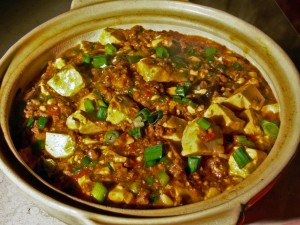Thanks for being so patient while I bunked off from blogging and from my other work for an indolent week. It’s been lovely – I’ve been to the seaside, got sunburned, drunk lots of lovely summery booze, eaten some great meals, and done lots of work on new recipes: it means I’m able to come back to you fully recharged. There’s lots to look forward to over a very busy couple of months to come, when I’ll be blogging from Cardiff, a cruise ship just outside Southampton, New Orleans, then Vegas and Phoenix – you can probably see why I felt I needed a short break before getting back down to things!
So then: som tum. You might have ordered this dish (and if you haven’t, you should; I’d rate it as one of the world’s best salads) in a good Thai restaurant. Green papaya makes the base of this salad, its dense, crisp texture made the most of with some careful shredding with a sharp knife. It’s bathed in a dressing which, for me, promotes it right to the head of the international salad flavour conspiracy. (See also: coban salatasi, panzanella and Swedish cucumber salad.) Som tum dressing touches every part of your tongue. It’s sweet with palm sugar, salty and umami with fish sauce and dried shrimp, sour with fresh lime juice, and spiked with chilli to give the whole mouth heat. Some aromatic herbs give it a lovely nose as well – for my tastes, this is about as good a picnic dish as you could make.
Green papaya is surprisingly neutral in flavour. If you can’t find any, Natacha de Pont du Bie, who encountered it in Laos, found to her pleasure that you can substitute a raw turnip in similar Laotian salads and that doing so will even fool Laotians, so I don’t see why you shouldn’t make the same substitution here. My papaya came from the Chinese supermarket on the railway bridge on Mill Road in Cambridge, and other oriental supermarkets with good fruit and veg sections will probably be able to help you too.
To serve up to six as a side dish, you’ll need:
1 green papaya
2 fat cloves of garlic
1 Scotch bonnet chilli (or three or four Thai bird’s eye chillies)
1 small handful (about 20g) dried shrimp (available from the Chinese supermarket in the chiller section)
8 cherry tomatoes
Juice of 2 limes
2 tablespoons fish sauce
2 tablespoons palm sugar (use soft dark brown sugar if you can’t find any)
1 large handful coriander, chopped finely
1 small handful mint, chopped finely
Start by shredding the papaya. Peel it with a potato peeler (surprisingly easy), and cut into the thinnest possible strips. Some find that holding the papaya in one hand and making lengthways cuts like lots of guitar strings halfway into the fruit, then slicing down along those cuts so the shreds fall away from the fruit, is a good method. I prefer to cut the whole fruit into thin pages, and then cut piles of those into strips, because I have trouble with the hollow centre of the fruit when using the first method. Put the shredded papaya into a large bowl.
Crush the garlic thoroughly in a pestle and mortar, and add the shrimp, pounding it with the garlic for about 20 seconds. The shrimp won’t reduce to shrimpy rubble, but they should be well-squished and full of flavour from the garlic. Mix the garlic and shrimp well with the papaya in the large bowl, and add the halved tomatoes, tossing everything in the bowl thoroughly as if to bruise the tomatoes and papaya a little.
Make the dressing in a jam jar so you can adjust seasoning as you go. Add the lime juice, fish sauce, palm sugar and very finely chopped chilli to the jar and shake it with the lid on until the palm sugar has dissolved. Taste the sauce – you may feel it needs to be sweeter, saltier or more sour depending on your taste, so adjust it with some extra juice, sauce or sugar. Pour it over the salad in the bowl, add the finely chopped herbs and toss vigorously again.
This salad will hang around happily for hours, so it’s great to take to a picnic. I particularly love it with fatty meats or barbecued foods, or, of course, to accompany a Thai main dish.
Will you look at that – a hailstorm. Looks like I chose just the right moment to get back to work.

